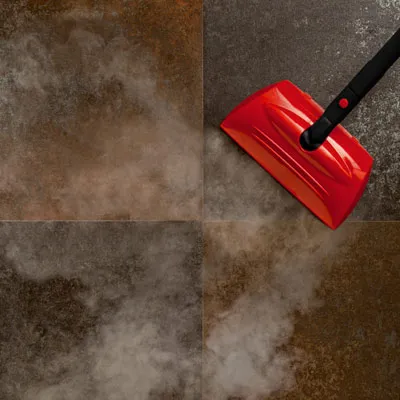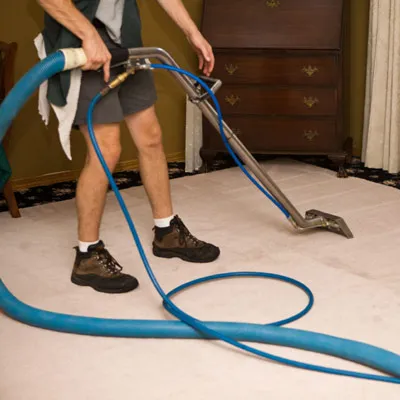Steam cleaning is an effective and eco-friendly way to clean various surfaces in your home or business. Whether steam cleaning is right for you depends on the surfaces you need to clean, the features you want from a cleaner, and whether it’s safe for you. Read our guide below to learn how steam cleaners work, how to use a cleaner properly, and their pros and cons.
What Is Steam Cleaning?
Steam cleaning uses high-temperature water vapor to remove dirt, grime, and stains from various surfaces. This process involves heating water to its boiling point, which creates pressurized steam that you can direct onto surfaces that need cleaning. The heat and moisture from the steam work together to loosen dirt and kill harmful microorganisms without the need for harsh chemicals.

How Steam Cleaners Work
When you heat water past its boiling point (212°F or 100°C), it turns into steam. A steam cleaner then pressurizes the steam and focuses it out through a nozzle or attachment. The high temperature of the steam loosens dirt and grease, and makes it easy to wipe away. It also kills many types of bacteria, dust mites, mold spores, and other allergens on contact.
Types of Steam Cleaners
There are several types of steam cleaners available, and each is designed for specific cleaning needs. Below are some of the most popular models:
- Canister steam cleaners: Versatile machines with various attachments for multiple cleaning tasks
- Commercial steam cleaners: Heavy-duty machines for industrial or large-scale cleaning operations
- Handheld steam cleaners: Compact and portable, ideal for small cleaning tasks
- Steam mops: Feature a long handle and floor attachment
Benefits of Steam Cleaning
Steam cleaning offers numerous advantages over traditional cleaning methods. Read more about the pros below.
Chemical-free Cleaning
One of the primary benefits of steam cleaning is that you can clean surfaces effectively without using chemicals. This makes it an eco-friendly choice and better for homeowners with sensitivities to cleaning products. It’s also a better choice for households with children or pets because there are no chemicals.
Better for Allergies
Steam cleaning eliminates dust mites, mold spores, and other allergens without harsh chemicals, which makes it ideal for people with allergies. Steam cleaning mattresses, upholstery, and carpets regularly can reduce allergens and improve indoor air quality.
Effective Sanitization
Steam cleaning kills up to 99.9% of bacteria, dust mites, mold spores, and other harmful microorganisms. This sanitizing power is especially valuable in kitchens, bathrooms, and other areas where germs are likely to accumulate.
Best Surfaces for Steam Cleaning
You can use a steam cleaner on a wide variety of soft and hard surfaces. It works best for these hard surfaces:
- Countertops (granite, quartz, and other sealed stone surfaces)
- Laminate flooring
- Sealed hardwood floors
- Tile and grout
- Vinyl flooring
You can also use a steam cleaner to clean the following types of soft surfaces:
- Carpets (with appropriate attachments)
- Curtains
- Mattresses
- Upholstery
Steam cleaning refreshes these surfaces, removes odors, and eliminates dust mites and other allergens that may be lurking in fabric.
Surfaces To Avoid When Steam Cleaning

Avoid using a steam cleaner on the surfaces below, as it can lead to damage:
- Cold glass, which can crack from rapid temperature change
- Delicate fabrics, such as silk or velvet
- Painted walls
- Unsealed hardwood floors
- Unsealed stone surfaces
Always check the manufacturer’s recommendations to determine whether you should use steam cleaning on a particular surface.
Choosing the Right Steam Cleaner
Steam cleaning is only effective when you choose the right steam cleaner for your needs. Read more about the most popular types of steam cleaners and their uses below.
Canister Steam Cleaners
Canister steam cleaners feature a large water tank and various attachments designed for different cleaning tasks. These cleaners are ideal for the following:
- Cleaning hard and soft surfaces
- Deep cleaning large areas
- Tackling multiple cleaning tasks in one session
Canister steam cleaners are frequently more expensive than other types, but offer the most flexibility and power.
Handheld Steam Cleaners
Handheld steam cleaners are compact and portable. They’re perfect for quick tasks and hard-to-reach areas, including those below.
- Cleaning small areas such as bathroom fixtures
- Refreshing upholstery and curtains
- Spot cleaning
Handheld units are convenient, but they usually have smaller water tanks than other models, and may require more frequent refilling.
Steam Mops
Steam mops are specifically designed for cleaning floors. They’re an excellent choice for the following:
- Cleaning sealed hardwood, tile, and laminate floors
- Regular floor maintenance
- Tackling kitchen and bathroom floors
Essential Features To Look For in a Steam Cleaner

Consider the following features when you’re shopping for a steam cleaner:
- Adjustable steam output: Allows you to control the amount of steam for different cleaning tasks.
- Continuous steam function: Eliminates the need to hold down a trigger constantly
- Large water tank capacity: Ensures long cleaning sessions without frequent refills
- Quick heat-up time: Should produce steam in as little as 30 seconds
- Variety of attachments: Offers versatility for cleaning different surfaces and areas
Step-by-Step Guide To Using a Steam Cleaner
Follow the steps below to get the most out of your steam cleaner:
Preparation
- Read the manufacturer’s instructions carefully.
- Fill the water tank with clean, cold water (use distilled water if recommended).
- Choose the appropriate attachment for the surface you’re cleaning.
- Clear the area of any loose debris or objects.
During Cleaning
- Allow the steam cleaner to heat up fully before use.
- Start with a small, inconspicuous area to test for any negative reactions.
- Move the steam cleaner slowly over the surface, allowing steam to penetrate and loosen dirt.
- Hold the steam nozzle in place for a few seconds before cleaning heavily soiled areas.
- Use a clean microfiber cloth to wipe away loosened dirt and excess moisture.
Post-cleaning Care
- Allow clean surfaces to dry completely.
- Empty and rinse the water tank after each use.
- Clean and dry all attachments before storing.
- Store the steam cleaner in a cool, dry place.
Common Steam Cleaning Mistakes To Avoid
Avoid these common steam cleaning mistakes to protect your surfaces:
- Using steam on unsealed surfaces
- Overusing steam on a single area, which can lead to oversaturation
- Neglecting to empty and clean the water tank after use
- Using tap water in areas with hard water (use distilled water instead)
- Forgetting to vacuum or sweep before steam cleaning
Maintaining Your Steam Cleaner
Follow these guidelines to properly maintain your steam cleaner:
- Clean or replace filters as recommended by the manufacturer.
- Descale the unit regularly, especially if you live in an area with hard water.
- Inspect hoses and attachments for wear, and replace as needed.
- Store the steam cleaner properly to prevent damage to hoses and attachments.
Safety Precautions When Steam Cleaning
Steam cleaning is generally safe, but it’s still important to follow these precautions:
- Allow surfaces to cool after steam cleaning.
- Always wear closed-toe shoes to protect your feet from hot steam.
- Keep the steam cleaner out of reach of children and pets.
- Never point the steam nozzle at people or animals.
- Use caution when cleaning electrical outlets or appliances.
Steam Cleaning: Our Conclusion
Steam cleaning is a powerful method of cleaning and sanitizing surfaces in your home without using chemicals or other harsh cleaning agents. It can clean both hard and hard surfaces, and kills various types of bacteria, which can improve your home’s air quality.
Steam cleaning is not suitable for every task, but a steam cleaner is still worth adding to your cleaning arsenal. You can keep your home clean and fresh if you follow proper steam-cleaning techniques and maintain your equipment diligently.
